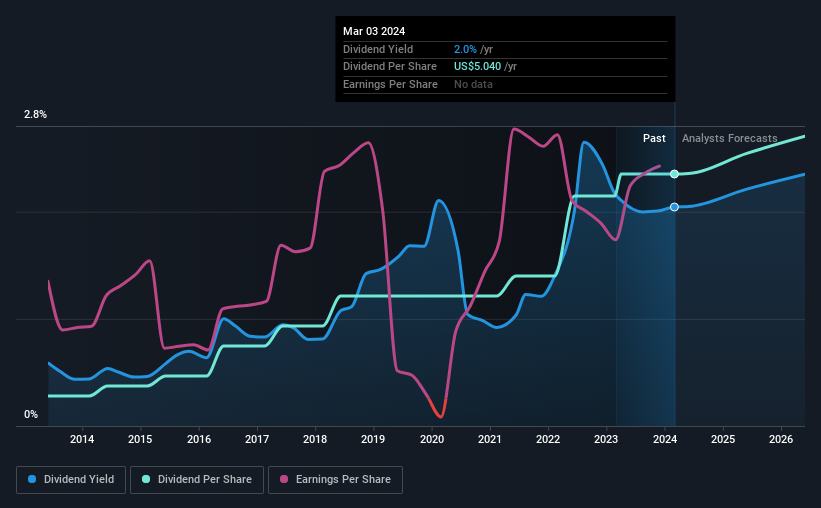Why You Might Be Interested In FedEx Corporation (NYSE:FDX) For Its Upcoming Dividend
FedEx Corporation (NYSE:FDX) stock is about to trade ex-dividend in four days. Typically, the ex-dividend date is one business day before the record date which is the date on which a company determines the shareholders eligible to receive a dividend. The ex-dividend date is important because any transaction on a stock needs to have been settled before the record date in order to be eligible for a dividend. Thus, you can purchase FedEx's shares before the 8th of March in order to receive the dividend, which the company will pay on the 1st of April.
The company's next dividend payment will be US$1.26 per share, and in the last 12 months, the company paid a total of US$5.04 per share. Based on the last year's worth of payments, FedEx stock has a trailing yield of around 2.0% on the current share price of US$246.60. Dividends are a major contributor to investment returns for long term holders, but only if the dividend continues to be paid. So we need to investigate whether FedEx can afford its dividend, and if the dividend could grow.
See our latest analysis for FedEx
Dividends are typically paid out of company income, so if a company pays out more than it earned, its dividend is usually at a higher risk of being cut. FedEx paid out a comfortable 29% of its profit last year. A useful secondary check can be to evaluate whether FedEx generated enough free cash flow to afford its dividend. Fortunately, it paid out only 30% of its free cash flow in the past year.
It's positive to see that FedEx's dividend is covered by both profits and cash flow, since this is generally a sign that the dividend is sustainable, and a lower payout ratio usually suggests a greater margin of safety before the dividend gets cut.
Click here to see the company's payout ratio, plus analyst estimates of its future dividends.
Have Earnings And Dividends Been Growing?
Companies that aren't growing their earnings can still be valuable, but it is even more important to assess the sustainability of the dividend if it looks like the company will struggle to grow. If earnings fall far enough, the company could be forced to cut its dividend. With that in mind, we're not enthused to see that FedEx's earnings per share have remained effectively flat over the past five years. It's better than seeing them drop, certainly, but over the long term, all of the best dividend stocks are able to meaningfully grow their earnings per share. Recent earnings growth has been limited. Yet there are several ways to grow the dividend, and one of them is simply that the company may choose to pay out more of its earnings as dividends.
The main way most investors will assess a company's dividend prospects is by checking the historical rate of dividend growth. In the last 10 years, FedEx has lifted its dividend by approximately 24% a year on average.
Final Takeaway
From a dividend perspective, should investors buy or avoid FedEx? The company has barely grown earnings per share over this time, but at least it's paying out a decently low percentage of its earnings and cashflow as dividends. This could suggest management is reinvesting in future growth opportunities. Generally we like to see both low payout ratios and strong earnings per share growth, but FedEx is halfway there. It's a promising combination that should mark this company worthy of closer attention.
On that note, you'll want to research what risks FedEx is facing. To help with this, we've discovered 1 warning sign for FedEx that you should be aware of before investing in their shares.
Generally, we wouldn't recommend just buying the first dividend stock you see. Here's a curated list of interesting stocks that are strong dividend payers.
Have feedback on this article? Concerned about the content? Get in touch with us directly. Alternatively, email editorial-team (at) simplywallst.com.
This article by Simply Wall St is general in nature. We provide commentary based on historical data and analyst forecasts only using an unbiased methodology and our articles are not intended to be financial advice. It does not constitute a recommendation to buy or sell any stock, and does not take account of your objectives, or your financial situation. We aim to bring you long-term focused analysis driven by fundamental data. Note that our analysis may not factor in the latest price-sensitive company announcements or qualitative material. Simply Wall St has no position in any stocks mentioned.

 Yahoo Finance
Yahoo Finance 
